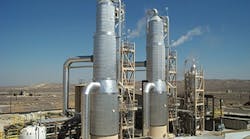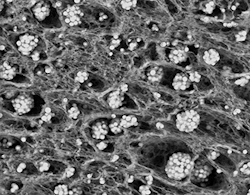Environmental Protection: Wastewater Takes A New Turn
Wastewater treatment is becoming an integral part of processes at many plants as more and more chemical makers worldwide strive to achieve or at least approach zero liquid discharge (ZLD). At the same time, developments in technology are helping both to increase the percentage of usable water recovered and the capture of potentially valuable contaminants.
“The bottom line is that companies are trying to reuse and recover as much water as possible — whether it’s because of operating in a water-stressed area or because of local regulations regarding potable water use. The key is finding innovative ways to increase water recovery while at the same time preserving overall process reliability,” says Bill Heins, Bellevue, Wash.-based global leader for market development, Suez Water Technologies & Solutions.
For example, if a plant needs to go to ZLD, then Suez works to increase water recovery on the membrane side and so make evaporator/crystallizer equipment smaller (Figure 1) — with an associated decrease in operational cost (opex) and capital investment (capex). “There is a big drive to use this approach now,” he notes.
Another approach involves very high recovery reverse osmosis (RO) systems. “The reject from these doesn’t need an evaporation unit at all and can pass straight into a crystallizer. So, if you can increase RO-based water recovery, you can decrease size and, therefore, cost and energy consumption of the overall ZLD system,” explains Heins.
Standardization and modularization of ZLD equipment are increasingly popular, too, because they can reduce expensive field rework and speed up construction, he observes. Suez began its modularization work 15 years ago and now is in its fifth generation of modular design, Heins adds. The company can modularize any required technology. “So, for example, in remote regions everything is fully containerized — RO, nanofiltration (NF), whatever technology is needed.”
Figure 1. Making evaporator/crystallizer equipment smaller decreases opex and capex. Source: Suez Water Technologies & Solutions.
“We have a lot of interesting innovations, for example on tackling pressure limitations and temperature limitations. New materials and designs are certainly helping us to overcome these challenges,” he says.
One example is with high temperature (100°C) RO. Inherently hot waste streams need cooling prior to processing in a membrane system. However, this often results in unwanted precipitation of organic compounds and increased fouling potential. “So, it many cases, it may be desirable to design membrane systems to operate at elevated temperatures,” notes Heins.
Another example is on the thermal side, with the evaporators and crystallizers used in ZLD processes: “You can get very high concentrations of salt which can be very corrosive. So, we are working to operate processes at lower temperatures — which will also lower the cost of materials of construction.”
[callToAction]
High temperatures and pressures and extreme pH conditions remain challenges but the key, according to Heins, is integration of your wastewater treatment technologies.
Most of Suez’s wastewater treatment projects fall into two categories: recovery and reuse of water from a wastewater stream to reduce demand for fresh water; and that plus resource recovery. In the latter category, the company is becoming a specialist in lithium recovery from its involvement in treating wastewater from both mining and plants.
Potent Pairing
DuPont Water Solutions (DWS), Edina, Minn., has found that teaming ultrafiltration (UF) and RO filtration technologies can purify up to 70% of wastewater for reuse.
“The contamination level of the wastewater entering these UF and RO systems is usually elevated compared to typical surface or well water treatment systems; therefore, we’ve focused on further developing UF and RO technology with fouling resistance to improve the operational reliability,” explains DWS principal research scientist Tina Arrowood.
Companies in water-scarce regions now are pushing to recover up to 95% of their wastewater for operational reuse, she notes. However, that poses challenges because the levels, e.g., of suspended solids, hardness, dissolved organics and salt, exceed those suitable for traditional RO recovery methods.
Here, DWS uses a minimal liquid discharge (MLD) approach that involves tailoring a core set of technologies — RO, UF, NF and ion exchange (IX) — to the specific application to maximize high-quality permeate for reuse. The company continually updates its technologies; five different filter elements and membranes were introduced fairly recently.
“By combining these technologies, the MLD process can convert wastewater into a reliable source of water for an industrial plant. Applying MLD tackles industrial water management on both ends and reduces dependency on freshwater withdrawal, while also lowering the industrial plant’s discharge footprint in both liquid and solid waste,” says Arrowood.
Successful operation requires the proper sequence of RO element types throughout a treatment train to meet specific water recovery and reuse targets.
Here, she cites the example of a textile mill whose wastewater contained 7,000 mg/L of total dissolved solids and 150 mg/L of COD after primary and secondary wastewater treatment. These values rose to 140,000 mg/L and 3,000 mg/L, respectively, after 95% of the water was recovered by an MLD process.
“Treating water over this range of composition requires more than one RO element type to optimize the energy, reliability and permeate quality throughout the pure water recovery process. The choice of RO element and the attributes that element provides must align with the changing treatment demands as the wastewater is concentrated,” she stresses.
Employing an MLD approach in conjunction with ZLD can reduce costs by up to 60%, Arrowood asserts. MLD recovers with inexpensive membrane processes up to 95% of the wastewater for reuse and reduces the volume of water requiring final dewatering via expensive thermal ZLD methods.
Figure 2. Scanning electron micrograph shows structure that underpins enhanced performance of organism. Source: Microvi.
As an example, she points to a chemical plant in China that was using RO elements in an MLD process to recover an additional 90% of purified water from the concentrate of its primary wastewater recovery system and, thus, decrease the wastewater volume needing thermal dewatering to achieve ZLD. A year later, the site upgraded its MLD process by adding a NF unit to treat the concentrated waste brine stream from the RO system and convert more than 60% of this water into a purified sodium chloride solution for reuse. This upgrade enabled reducing by half the nearly 40 t/d of solid ZLD waste destined for landfill.
Innovations such as these together with new product releases such as durable, fouling-resistant elements will fill critical gaps in cost/performance in a variety of water treatment and reuse applications, Arrowood believes.
Better Biological Processing
Meanwhile, Microvi, Hayward, Calif., has developed a proprietary platform called MicroNiche Engineering (MNE). The company uses this to create novel biocatalysts that intensify biological processes by increasing the organism density by orders of magnitude while reducing reactor sizes and simplifying the process treatment train.
“We use MNE to re-create features of an organism’s natural habitat, or microniche, which helps optimize the performance of organisms in industrial bioprocesses. While the development process is complex, the outcome is remarkably simple: nearly any organism optimized for nearly any bioprocess — deployed in the versatile format of an MNE biocatalyst composite,” explains Ameen Razavi, director of innovation research.
In many cases, users simply can drop MNE biocatalysts into their existing reactor or vessel. A composite (Figure 2) can come in a variety of forms and geometric configurations to suit particular process requirements.
The company has developed more than 6,000 different composites so far. If an application requires removal of NOx, SOx and volatile metals from flue gases, for example, up to 100 may get tested to identify the single best-performing biocatalyst to use.
Because the high-density organism population is so controlled, the reaction doesn’t produce biosolids. Treatment generally involves a single pass with the biocatalyst retained in the reactor at all times. Microvi’s first commercial system, at a site in Australia, has run for a number of years with no recycle, recharge or replenishment of the biocatalysts, says the firm.
“The key advantages of the Microvi technologies include: ease of use, minimal maintenance requirements, robustness across changing operating conditions, longevity, the ability to work across a range of temperatures (including some applications, such as wastewater treatment, at temperatures as low as 4°C), and a reduction in lifecycle costs on the order of 30–50%,” says Razavi.
The company’s latest move is a tie-up with Scottish Water, Dunfermline, Scotland. It has installed a fully automated, purpose-built wastewater treatment pilot plant in Bo’ness, Scotland, with the aim of developing catalysts capable of reducing ammonia and organic carbon pollutants.
Here, it is using an existing, safe species of organism rather than creating a specific one for this waste. If the trial is successful, the same biocatalyst could be applied across a broad spectrum of wastewater treatment plants.
“Our biggest engineering challenge is optimizing the integration of the biocatalyst into existing tanks and re-using mechanical equipment to minimize costs. As a result, we are testing different configurations to give us maximum flexibility, given the variability in asset types we would come across,” he notes.
Razavi describes the results of phase one testing at the plant as exceptional. Scottish water now has extended the trial until June to enable investigating different process configurations. If the extended run achieves the same level of success, a full-scale demonstration plant would be the logical next step, he believes.
Wastewater treatment isn’t the company’s only focus. The technology also can play a role in providing clean water from ground and surface water, recovering valuable nutrients such as phosphorus from wastewater, and converting a variety of solid and gaseous feedstocks into fuels, chemical intermediates, and specialty chemicals, it says.
Treatment As A Service
For its part, InOpSys, Mechelen, Belgium, manages typically non-recyclable process streams by recovering water, raw materials and valuable components such as zinc and lead with an on-site flexible modular mobile unit (FMMU) that uses an advanced oxidation process. The company primarily focuses on biopharmaceuticals and fine chemicals.
A plant doesn’t incur any capex for the FMMU; instead, it pays based on the quantity of treated wastewater. That wastewater then can go to the site’s own treatment facilities rather than to offsite incineration.
“We design, test, construct and operate the FMMUs on-site. The service is offered as an opex,” explains CEO Steven De Laet.
Janssen Pharmaceutica, Beerse, Belgium, exemplifies this strategy in action, he says. Janssen manufactures over 30 products at Beerse, including ovarian and breast cancer treatment doxorubicin and Crohn’s disease treatment ustekinumab.
The company is committed to closing the material loops in its manufacturing processes and turned to InOpSys in an effort to tackle a difficult-to-process waste stream containing zinc. Janssen has had to store that waste stream and then send it to an industrial incinerator.
The two companies worked together to develop a recycling process to remove and recover the zinc from the waste stream. The zinc essentially reacts with sodium sulfide to form zinc sulfide, which is extremely insoluble in water. This is removed as a zinc sludge and then used by metal specialist Nyrstar, Balen, Belgium, in its zinc production process. Because the wastewater stream now is devoid of zinc, it can go to Janssen’s onsite wastewater treatment plant.
“We are now expanding our activities within Europe and perhaps also North America,” notes De Laet.





